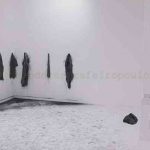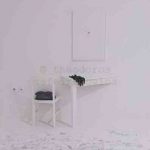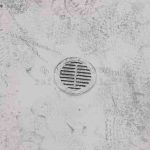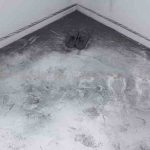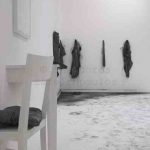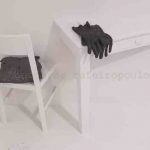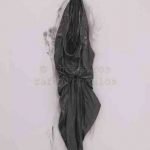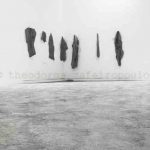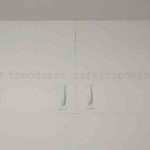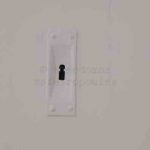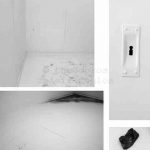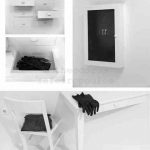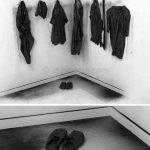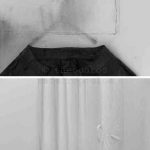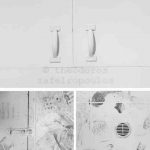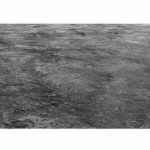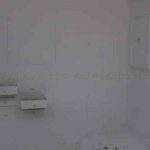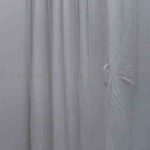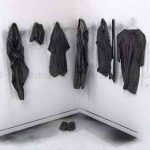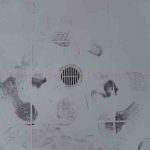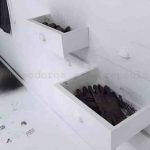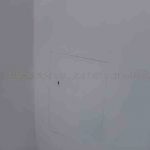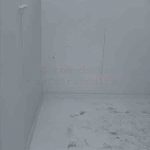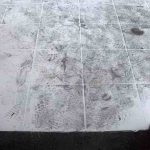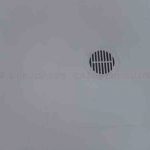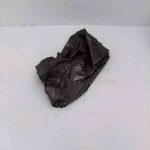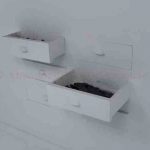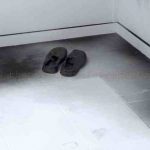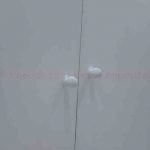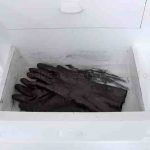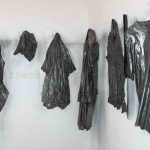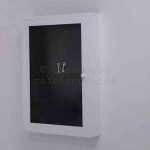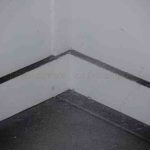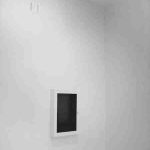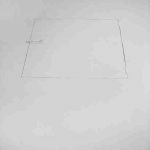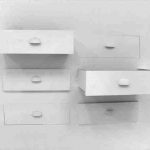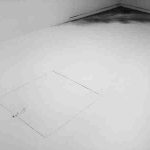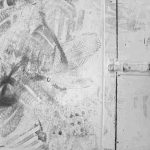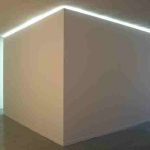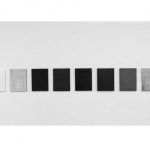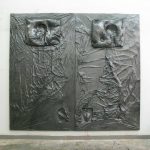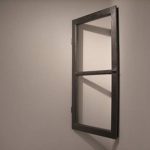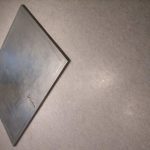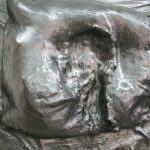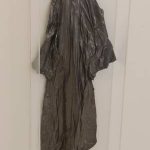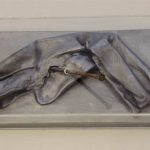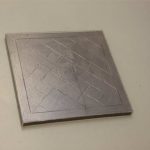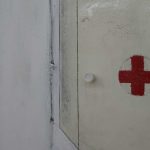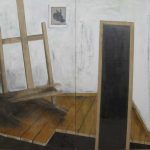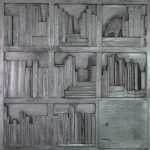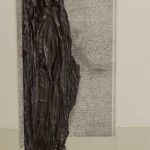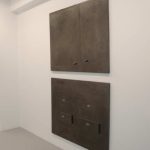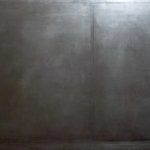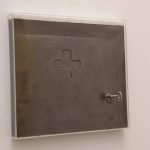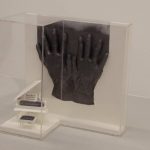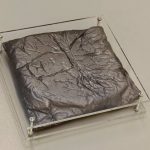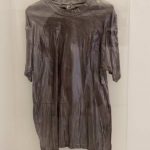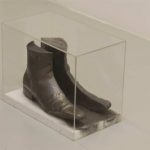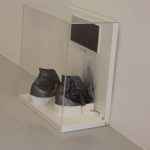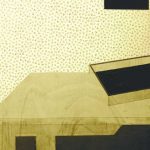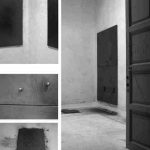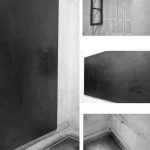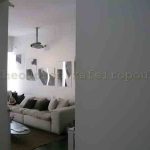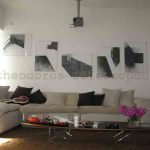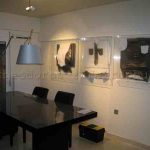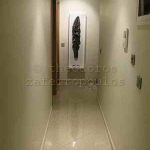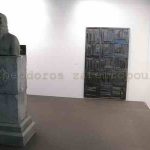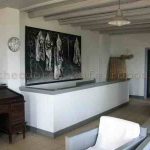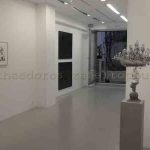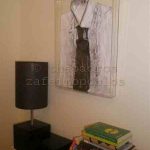6B Installation
(2005-2006)
A visit at the workshop of Theodoros Zafeiropoulos
Even though since the era of the ready-made by Marcel Duchamp so many have changed– and even more seem to have been called off- the relationship between art and illusion remains inexhaustible. Even in the most radical and subversive expressions of modern or contemporary visual poetics, the illusion “is there”, present to remind us that nothing has really changed, that only the rules of the game that have changed. Besides, the secret precept left by Marcel Duchamp to contemporary humanity is a construction(the well-known Etant Données) which, in an enigmatic as well as discreetly infernal way, forces us to decipher it only after we adopt the classical view of the renaissance observer: in a few words, only if we gaze the suggested illusionist image from the point of view of the still, one-eyed and yet indiscreet voyeur- witness. Even if it would be a true fact the notion that today the objects have conclusively lost their shadow, the very mystery of their existence and of the real or non-real relationship with space, will forever remain open. Thus, from the illusionist extension of space carried our by Jan Van Eyck – through the mirror adoring the of house owned by the Arnolfini couple – from Las Meninas by Velasquez, the Βar of the Folies Bergère by Μanetuntil the modern scenarios of several Virtual Realities, painting and visual creation in general has never ceased to function as a machine producing illusions; one that some times offers us games of visual bliss while at other times, it helps us to take a plunge into the ultimate uncertainty and in awe. The most recent visual installation / interaction of Theodoros Zafeiropoulos, merges but also renews – the most appropriate word would be redefines- some of the most essential and fundamental questions of the poetics of illusion. I am at ease with the word poetics and not “application” or simply “technique” because I believe that since the era of Apellisthe use of the rules of illusion had also a symbolic meaning and significance. Although he is still very young, Theodoros Zafeiropoulos seems to grasp the fact that the relationship between “reality” and “delusion” is the most exciting and at the same time the most undermining question ever to have been posed to painting for itself as well as the arts of depiction in general. His white “workshop” – as provocative as the sheet of blank paper was for the poet Mallarmé – dwells once more on a finding coming from the western tradition, known from the era of Carlo Crivelli, which has been developed in a very impressive way by the Fleming, the Dutch and the Spanish artists of the 17th century. It refers to the painting that tends to overextend the very limits of the painting itself (that is the limits of its conventional frame) and stretch to the outskirts, thus extending its own “truth” in the surrounding space. We are dealing here with a bold conception of the traditional illusionist painting which, when the revolution of modernism came to pass, functioned subversively complying to different aesthetic and artistic values. The rush of the imaginative in the surrounding space is not suggested anymore as an original find or a visual game, but mostly as an attempt (and at the same time as a longing) to identify the illusion with the real, fourth-dimensional space. Wasn’t indeed the consonance between art and life one of the most fundamental dictates of the pioneering movements of the 20th century? In the work of Theodore Zapheiropoulos the real wall of the exhibition space becomes the surface (the white canvas) on which the objects that usually weave the familiar setting of a workshop are drawn. Closets, doors, drawers, hooks, hangers state their existence simply as outlines with the only real elements being some door handles and half-open drawers that are half built –in to the wall. In this manufactured environment – where the real space “imitates” that of imagination – the figural and notional transmutation of a series or real clothes has the most prominent place; these clothes have been faced with several coats of graphite so that the cold and at the same time heavy feeling of metal can emerge. In his own words, these clothes are the bearers of the “dirt” (of the grime) he experienced in his workshop, same for anyone involved in a specific labor either it leaves stains on one’s skin or not. The adventure of thetrace however, is detected mainlyin the relationship between the visitor itself and the space. At the entrance of the “workshop” the pile of graphite on the small rug is staining instead of cleaning the shoes of the visitor / observer with this particular material. Undoubtedly, the all -white floor functions as another, horizontal this time, surface of ready canvas on which the traces of the dirty shoes will be drawn. Does the exit of this work of art into the real world make art much more familiar or the real space more submit to the imaginary? In the end, one has the impression that the visitors come through an actual gate into an imaginary space, thus being transformed into ghosts ready to disappear like unas ombra, una ficcion, as the play wright Calderon de la Barca would say.
Niki Loizides
Art Historian
Professor of the Athens School of Fine Arts
Μια επίσκεψη στο εργαστήρι του Θεόδωρου Ζαφειρόπουλου
Αν και από την εποχή των ready – mades του Marcel Duchamp πολλά έχουν αλλάξει – και ακόμα περισσότερα μοιάζουν να έχουν ματαιωθεί- η σχέση τέχνης και ψευδαίσθησης παραμένει ανεξάντλητη. Ακόμα και στις πιο ανατρεπτικές εκφράσεις της μοντέρνας ή σύγχρονης εικαστικής ποιητικής, η ψευδαίσθηση “είναι εκεί “ για να μας υπενθυμίζει ότι τίποτα πραγματικά δεν τελείωσε και ότι απλά και μόνο οι κανόνες του παιχνιδιού έχουν αλλάξει. Εξάλλου η μυστική υποθήκη που άφησε ο Marcel Duchamp στη μοντέρνα ανθρωπότητα είναι μια κατασκευή ( το γνωστό Etant Données) η οποια, με τρόπο αινιγματικό όσο και διακριτικά υποχθόνιο, μας υποχρεώνει να την αποκρυπτογραφήσουμε μόνο αφού υιοθετήσουμε την κλασική στάση του αναγεννησιακού παρατηρητή: με λίγα λόγια, μόνο αν ατενίσουμε την προτεινόμενη ψευδαισθησιακή εικόνα από την θέση του ακινήτου, μονόφθαλμου όσο και αδιάκριτου ηδονοβλεψία- μάρτυρα. Ακόμα κι αν αληθεύει το γεγονός ότι σήμερα τα αντικείμενα έχουν πλέον τελεσίδικα χάσει τη σκιά τους, το μυστήριο της υπόστασής τους και της πραγματικής ή μη σχέση τους με το χώρο, θα παραμείνει ανοιχτό εσαεί. Έτσι, από την ψευδαισθησιακή προέκταση του χώρου που επιχειρεί ο JanVanEyck- μέσα από τον καθρέφτη που κοσμεί τον τοίχο της οικίας του ζεύγους Arnolfini- από το Las Meninas του Velasquez, το Βar των Folies Bergère του Μanet μέχρι τα σύγχρονα σενάρια των Virtual Realities, η ζωγραφική και γενικότερα η εικαστική δημιουργία δεν έπαψε να λειτουργεί σαν μια μηχανή παραγωγής της ψευδαίσθησης που πότε μας χαρίζει παιχνίδια οπτικής ευδαιμονίας και πότε μας βυθίζει στην έσχατη αβεβαιότητα και στο δέος. Η τελευταία εικαστική εγκατάσταση / διάδραση του Θεόδωρου Ζαφειρόπουλου συναιρεί αλλά και ανανεώνει – η σωστότερη λέξη θα ήταν επανασημασιοδοτεί – μερικά από τα ουσιαστικότερα και πρωταρχικά ερωτήματα της ψευδαισθησιακής ποιητικής. Χρησιμοποιώ τη λέξη ποιητική και οχι “πρακτική” ή απλά “τεχνική” διότι πιστεύω ότι από την εποχή του Απελλή η χρήση των κανόνων της ψευδαίσθησης είχε σημασία και συμβολική. Αν και ακόμα πολύ νέος, ο Θ.Ζαφειρόπουλος φαίνεται να έχει κατανοήσει ότι η σχέση “πραγματικότητας” και “πλάνης” είναι το πιο συναρπαστικό και ταυτόχρονα το πιο υπονομευτικό ερώτημα που έθεσε ποτέ στον εαυτό της η ζωγραφική και γενικότερα οι τέχνες της αναπαράστασης. Το λευκό “εργαστήρι” του – προκλητικό όσο και το φύλλο του άγραφου χαρτιού για τον ποιητή Mallarmé – επαναπραγματεύεται ένα εύρημα της δυτικής παράδοσης γνωστό από την εποχή του Carlo Crivelli, το οποίο και αξιοποιήθηκε με τρόπο ιδιαίτερα εντυπωσιακό από τους Φλαμανδούς, τους Ολλανδούς και τους Ισπανούς καλλιτέχνες του 17ου αιώνα. Πρόκειται για τον πίνακα που τείνει να υπερβεί τα όρια του πίνακα (δηλαδή τα όρια του συμβατικού του πλαισίου) και να απλωθεί προς τα έξω προεκτείνωντας έτσι τη δική του “αλήθεια” μέσα στον περιβάλλοντα χώρο. Εδώ έχουμε να κάνουμε με μια τολμηρή επινόηση της παραδοσιακής ιλλουζιονιστικής ζωγραφικής η οποία με την επανάσταση του μοντερνισμού λειτούργησε ανατρεπτικά υπακούοντας σε διαφορετικές αισθητικές και καλλιτεχνικές αξίες. Η εφόρμηση του φαντασιακού μέσα στον περιβάλλοντα χώρο δεν προτείνεται πλεον ως εύρημα ή εικαστικό παιχνίδι αλλά ως απόπειρα (και προσδοκία) ταύτισης του ψευδαισθιακού με τον πραγματικό χώρο. Η ταύτιση τέχνης και ζωής δεν υπήρξε μήπως ένα από τα βασικότερα προστάγματα των πρωτοποριακών κινημάτων του 20ου αιώνα; Στο έργο του Θεόδωρου Ζαφειρόπουλου ο πραγματικός τοίχος του εκθεσιακού χώρου γίνεται η επιφάνεια (ο λευκός καμβάς) πάνω στον οποίο σχεδιάζονται τα αντικείμενα που συνήθως συνθέτουν το οικείο εσωτερικό ενός εργαστηρίου. Ντουλάπες, πόρτες, συρτάρια, γάντζοι, κρεμάστρες δηλώνονται απλά ως περιγράμματα με μοναδικό υπαρκτό στοιχείο μερικά πόμολα και μισάνοιχτα συρτάρια ψευδοενσωματωμένα στον τοίχο. Μέσα στο κατασκευασμένο αυτό περιβάλλον – όπου ο πραγματικός χώρος “μιμείται” τον φανταστικό – εξέχουσα θέση κατέχει η μορφική και νοηματική μετάλλαξη μιας σειράς πραγματικών ρούχων εργαστηρίου τα οποία έχουν υποστεί αλλεπάλληλες επιστρώσεις από γραφίτη έτσι ώστε να δίνουν την παγερή και συνάμα βαριά αίσθηση του μετάλλου. Όπως εξηγεί ο ίδιος, τα ρούχα αυτά είναι φορείς της “βρωμιάς” (της μουτζούρας) που έζησε στο εργαστήριο και που βιώνει ο καθένας που εμπλέκεται με μια συγκεκριμένη εργασία είτε αυτή αφήνει ίχνη στο δέρμα του είτε όχι. Ωστόσο, η περιπέτεια του ίχνους εντοπίζεται κυρίως στη σχέση του ίδιου του επισκέπτη με το χώρο. Στην είσοδο του “εργαστηρίου” ο συσσωρευμένος στο μικρό χαλί γραφίτης λερώνει, αντί να καθαρίζει, τα υποδήματα του επισκέπτη / παρατηρητή με το συγκεκριμένο υλικό. Αναπόφευκτα, το κατάλευκο δάπεδο λειτουργεί ως μια άλλη, οριζόντια αυτή τη φορά, επιφάνεια έτοιμου καμβά πάνω στον οποίο θα σχεδιαστούν τα ίχνη από τα λερωμένα υποδήματα. Η έξοδος του έργου στον πραγματικό χώρο καθιστά την τέχνη πιο οικεία ή τον πραγματικό χώρο περισσότερο υποταγμένο στο φαντασιακό; Τελικά, έχει κανείς την αίσθηση ότι οι επισκέπτες εισχωρούν μέσα από μια πραγματική πύλη σ΄ένα χώρο φαντασιακό μεταβαλλόμενοι έτσι σε φάσματα έτοιμα να εξαφανιστούν σαν unas ombra, una ficcion, όπως θα έλεγε και ο θεατρικός συγγραφέας CalderondelaBarca.
Νίκη Λοϊζίδη
Ιστορικός Τέχνης
Καθηγήτρια Ανωτάτης Σχολής Καλών Τεχνών
Batagianni Gallery Installation views
6B Objectiveness
(2004 – 2005)
